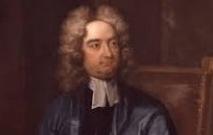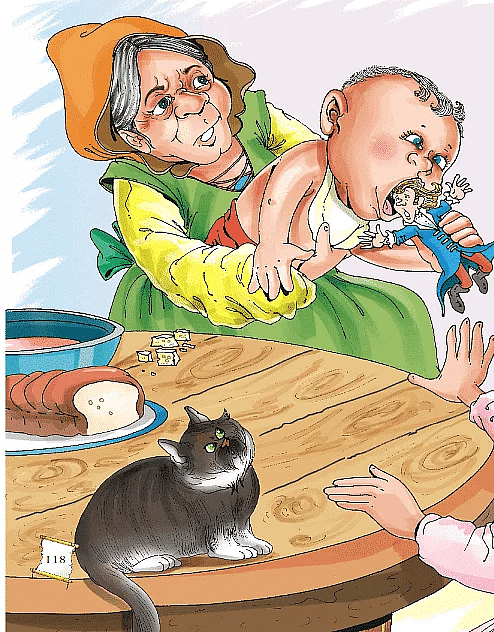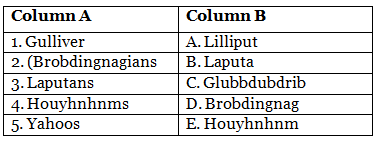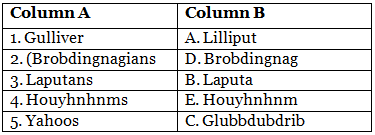Worksheet Solutions: Gulliver`s Travels | English Marigold Class 5 PDF Download
| Table of contents |

|
| Multiple Choice Questions (MCQs) |

|
| Fill in the blanks |

|
| True or False |

|
| Match the columns |

|
| Short Answer Questions |

|
| Passage-Based Questions |

|
Multiple Choice Questions (MCQs)
(i) Who is the author of "Gulliver's Travels"?
(a) William Shakespeare
(b) Charles Dickens
(c) Jonathan Swift
(d) Jane Austen
Ans: (c)
"Gulliver's Travels" is a classic work of satire written by Jonathan Swift in 1726. (ii) How many main voyages does Gulliver undertake in the story?
(ii) How many main voyages does Gulliver undertake in the story?
(a) Two
(b) Three
(c) Four
(d) Five
Ans: (c)
Gulliver undertakes four main voyages throughout the story, each to a different land with unique inhabitants.
(iii) In which country does Gulliver first find himself?
(a) Brobdingnag
(b) Lilliput
(c) Laputa
(d) Houyhnhnm Land
Ans: (b)
Gulliver first finds himself shipwrecked on the island of Lilliput, where the inhabitants are only six inches tall.
(iv) What is the name of the island where people are giants?
(a) Lilliput
(b) Brobdingnag
(c) Laputa
(d) Houyhnhnm Land
Ans: (b)
Brobdingnag is the land of giants, where Gulliver feels as small as the Lilliputians did in comparison to him.
(v) What is the island where the inhabitants are intelligent horses?
(a) Lilliput
(b) Brobdingnag
(c) Laputa
(d) Houyhnhnm Land
Ans: (d)
Houyhnhnm Land is the island where the intelligent, rational horses rule and the barbaric human-like creatures, the Yahoos, are subjugated.
Fill in the blanks
(i) Gulliver's Travels is a novel written by ____________.
(ii) Gulliver's first voyage takes him to the land of ____________.
(iii) In Gulliver's second voyage, he encounters the giants called the ____________.
(iv) Gulliver's third voyage is to the floating island of ____________.
(v) Gulliver's fourth and final voyage is to the land of the ____________.
Ans:
(i) Jonathan Swift
(ii) Lilliput
(iii) Brobdingnagians
(iv) Laputa
(v) Houyhnhnms
True or False
(i) Gulliver is a doctor.
(ii) In Lilliput, Gulliver is considered a giant.
(iii) The Laputans are known for their great physical strength.
(iv) The Yahoos are a race of intelligent horses.
(v) Gulliver's Travels is a satire on human nature.
Ans:
(i) True: Gulliver is a doctor by profession, which enables him to observe and understand the various societies he encounters throughout his travels.
(ii) True: In Lilliput, Gulliver is considered a giant because the Lilliputians are only six inches tall.
(iii) False: The Laputans are not known for their physical strength, but for their intellectual pursuits, such as mathematics, music, and astronomy.
(iv) False: The Yahoos are not intelligent horses but rather degenerate human-like creatures that are ruled over by the intelligent Houyhnhnms.
(v) True: Gulliver's Travels is considered a satire on human nature, as it exposes the flaws and follies of various societies and their inhabitants.

Match the columns
 Ans:
Ans:
Short Answer Questions
(i) Describe the physical appearance of the people of Lilliput.
Ans: The people of Lilliput are tiny, only about six inches tall. They are proportionally similar to average-sized humans but are just much smaller in size.
(ii) How does Gulliver end up in Brobdingnag?
Ans: Gulliver ends up in Brobdingnag after a giant eagle snatches him up and drops him into the sea, where he floats to the shore of the land of giants.
(iii) What is the primary difference between the Laputans and the people of other islands?
Ans: The primary difference between the Laputans and the people of other islands is their obsession with abstract knowledge and mathematics, to the point where they are often neglectful of practical matters.
(iv) How does Gulliver feel about the Houyhnhnms and the Yahoos?
Ans: Gulliver admires the Houyhnhnms for their rationality, intelligence, and peaceful society. He is repulsed and ashamed by the Yahoos, who represent the worst aspects of human nature.
(v) What is the overall message or theme of Gulliver's Travels?
Ans: The overall message or theme of Gulliver's Travels is the satirical critique of human nature, society, and political institutions. Through Gulliver's encounters with various fantastical societies, Swift exposes the flaws, hypocrisies, and follies inherent in humanity.
Passage-Based Questions
On the 16th of June 1730, we discovered land. Our captain sent a dozen men with vessels for water, if any could be found. When we came to land we saw no river or spring nor any inhabitants. I went on to explore. The country was barren and rocky. I turned back to join the crew, only to see them getting into the boat and rowing for life to get to the ship. Before I could reach them, I observed a huge creature walking after them in the sea as fast as he could. The water of the ocean reached only till his knees! However, the monster was unable to overtake the speeding boat. I turned back quickly and climbed up a steep hill with fields of barley on either side and the corn rising up to forty feet.
(i) What did the exploration party initially hope to find when they landed on the island?
Ans: They hoped to find water, as indicated by the captain sending men with vessels to collect it.
(ii) Describe the terrain of the island as observed by Gulliver.
Ans: The island was barren and rocky with no signs of water or inhabitants.
(iii) What urgent action did the crew take upon encountering the huge creature?
Ans: The crew hurriedly got into their boat and rowed quickly back to the ship to escape the creature.
(iv) How did Gulliver describe the size of the creature chasing the crew?
Ans: The creature was so large that the ocean water reached only up to his knees.
(v) Why was the creature unable to catch up to the crew's boat?
Ans: Despite its size and speed, the creature was unable to overtake the speeding boat.
(vi) What did Gulliver do after seeing the creature chasing the crew?
Ans: Gulliver quickly turned back and climbed up a steep hill bordered by fields of barley, with corn rising up to forty feet.
|
22 videos|195 docs|67 tests
|
FAQs on Worksheet Solutions: Gulliver`s Travels - English Marigold Class 5
| 1. What are the main themes explored in Gulliver's Travels? |  |
| 2. Who are the main characters in Gulliver's Travels? |  |
| 3. How does Swift use satire in Gulliver's Travels? |  |
| 4. What is the significance of the voyages in Gulliver's Travels? |  |
| 5. How does Gulliver's perspective change throughout the novel? |  |




















